I. Introduction
If you’re just getting started with raising egg laying chickens, you might feel overwhelmed by the countless breeds available on the market. I’ve been there too — standing in front of a sea of choices, unsure where to begin. But that’s actually great news! The more egg laying chicken breeds you have to choose from, the better your chances of finding the perfect match for your climate, goals, and lifestyle.
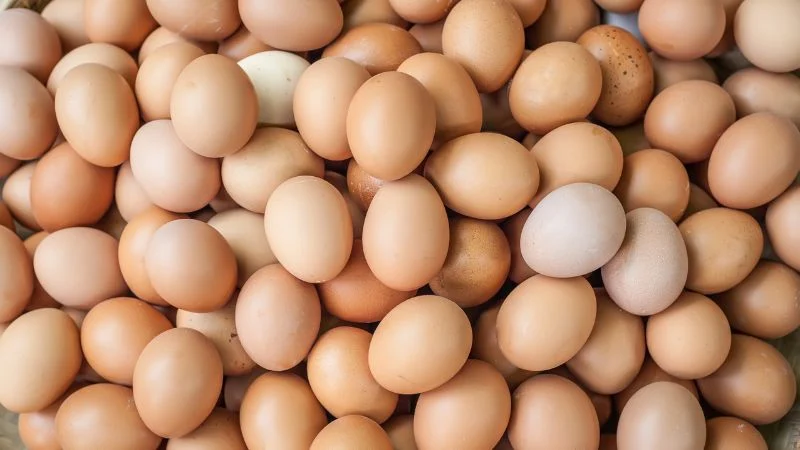
Every chicken breed has its own unique traits — from annual egg production, egg color, heat and cold tolerance, to temperament and care requirements. Understanding the popular breeds will make it much easier for you to pick the right one and successfully raise healthy hens.
In this article, I’ll share the “Top 5 Egg-Laying Chicken Breeds” based on various important factors, giving you a clear and well-rounded view to help you find the best breed for your needs. Let’s dive in!
II. 15 Popular Egg Laying Chicken Breeds in the U.S. & Top 7 Selection Criteria
Before diving into specific groups based on particular criteria, here’s a list of the 15 most popular egg laying chicken breeds commonly raised in the U.S. These breeds are frequently found on family farms, backyard coops, or small-scale operations:
List of 15 popular egg-laying breeds:
Orpington, Barred Rock (which is actually a variety of Plymouth Rock), Rhode Island Red, Sussex, Australorp, ISA Brown, Wyandotte, Easter Egger, White Leghorn, Ameraucana, Welsummer, Marans, Golden Comet, Olive Egger, and Silkie.
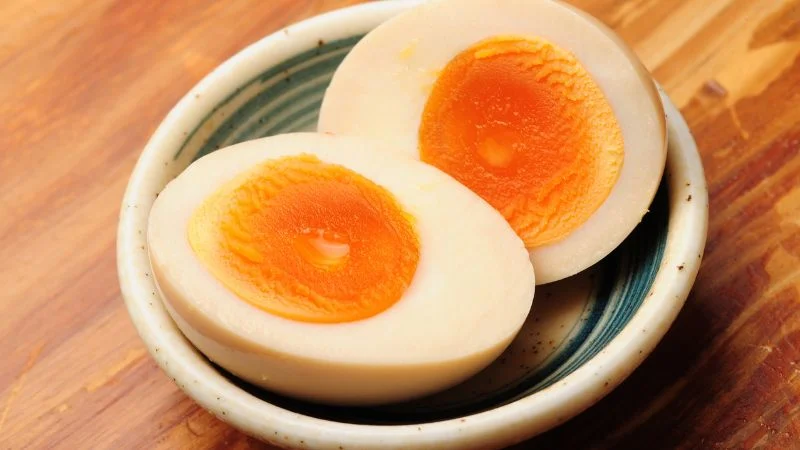
🧭 Explanation of the evaluation criteria for egg-laying breeds
To help you choose the right breed, I evaluated these 15 breeds based on 7 important criteria below. Each criterion is rated using a color system (🔷 Top 2, 🟢 Good, 🟡 Average, 🔴 Poor):
• 🥚 Egg Production: The average number of eggs a hen lays per year. Top-tier breeds typically produce 250–300+ eggs annually.
• 🍳 Egg Quality: Focuses on flavor, richness of the yolk, nutritional content, and freshness. Some breeds may not lay the highest quantity but are famous for their delicious and nutritious eggs — especially important for home egg consumption.
• 🛠️ Ease of Care: How easy the breed is to raise, including disease resistance and adaptability to different raising conditions. Ideal for beginners.
• 👶 Temperament: Friendliness, docility, and safety around children. Friendly breeds can become “pet hens” in your backyard.
• 🔇 Quietness: Some hens are relatively quiet and don’t cluck loudly — a great fit for those living close to neighbors or in residential areas.
• 🍗 Meat Quality: Although primarily egg layers, some breeds have tasty meat if you plan to utilize the birds after their laying cycle ends.
• 🎨 Egg Color: Eggs can range from white, brown, blue, olive green to dark chocolate. Many keepers appreciate colorful eggs for their aesthetic appeal and fun harvesting experience.
👉 Note: These ratings are comparative only within this selected group of 15 breeds and do not represent all chicken breeds raised in the U.S. I also want to be transparent that I have personally raised only some of these breeds. The rest of the assessments come from reputable sources, real-life experiences of other keepers, and the U.S. farming community. Therefore, this ranking should be used as a reference—especially useful for those considering which breed to raise for eggs at home.
🐔 Summary Table of 15 Chicken Breeds – 7 Criteria (Top Ratings Highlighted)
| Breed | Egg Production | Egg Quality | Ease of Care | Friendliness | Quietness | Meat Quality | Egg Color |
| Orpington (1) | 🟡 1 | 🟢 1 | 🟢 1 | 🔷 1 | 🟢 1 | 🟢 1 | 🟡 1 |
| Rhode Island Red (2) | 🟢 2 | 🟢 2 | 🟢 2 | 🟡 2 | 🟡 2 | 🟢 2 | 🟡 2 |
| Sussex (3) | 🟢 3 | 🟢 3 | 🟢 3 | 🟢 3 | 🟡 3 | 🟡 3 | 🟡 3 |
| Wyandotte (4) | 🟡 4 | 🟡 4 | 🟢 4 | 🟢 4 | 🟡 4 | 🟢 4 | 🟡 4 |
| Barred Rock (5) | 🟢 5 | 🟢 5 | 🔷 5 | 🟡 5 | 🟡 5 | 🟢 5 | 🟡 5 |
| Australorp (6) | 🔷 6 | 🔷 6 | 🟢 6 | 🟢 6 | 🟢 6 | 🟢 6 | 🟡 6 |
| ISA Brown (7) | 🔷 7 | 🟡 7 | 🔷 7 | 🟡 7 | 🟡 7 | 🔴 7 | 🔴 7 |
| Easter Egger (8) | 🟡 8 | 🟢 8 | 🟡 8 | 🟢 8 | 🟢 8 | 🔴 8 | 🔷 8 |
| Leghorn trắng (9) | 🔷 9 | 🟡 9 | 🟡 9 | 🔴 9 | 🔴 9 | 🔴 9 | 🔴 9 |
| Ameraucana (10) | 🟡 10 | 🟢 10 | 🟡 10 | 🟡 10 | 🟢 10 | 🔴 10 | 🟢 10 |
| Welsummer (11) | 🟡 11 | 🟢 11 | 🟡 11 | 🟡 11 | 🟡 11 | 🟢 11 | 🔷 11 |
| Marans (12) | 🟡 12 | 🔷 12 | 🟡 12 | 🟡 12 | 🟡 12 | 🟢 12 | 🔷 12 |
| Golden Comet (13) | 🔷 13 | 🟡 13 | 🟢 13 | 🟡 13 | 🟡 13 | 🔴 13 | 🔴 13 |
| Olive Egger (14) | 🟡 14 | 🟢 14 | 🟡 14 | 🟡 14 | 🟢 14 | 🔴 14 | 🔷 14 |
| Silkie (15) | 🔴 15 | 🟢 15 | 🟡 15 | 🔷 15 | 🔷 15 | 🟡 15 | 🟡 15 |
Additionally, I’ve created a summary table based on two specific criteria: heat tolerance and cold tolerance:
🐔 Summary Table of Heat & Cold Tolerance for 15 Chicken Breeds (U.S.)
| Breed | Heat Tolerance | Cold Tolerance |
| Orpington | 🟡 | 🔷 |
| Rhode Island Red | 🔷 | 🟢 |
| Sussex | 🟢 | 🟢 |
| Wyandotte | 🟡 | 🟢 |
| Barred Rock | 🟢 | 🔷 |
| Australorp | 🟡 | 🟢 |
| ISA Brown | 🔷 | 🔴 |
| Easter Egger | 🟢 | 🟢 |
| White Leghorn | 🔷 | 🔴 |
| Ameraucana | 🟢 | 🟡 |
| Welsummer | 🟢 | 🟡 |
| Marans | 🟡 | 🟡 |
| Golden Comet | 🔷 | 🔴 |
| Olive Egger | 🟢 | 🟡 |
| Silkie | 🔴 | 🟡 |
III. How to Choose the Right Chicken Breed for You
Honestly, during my research and while compiling this article, I sometimes felt a bit overwhelmed. The big question that kept popping up in my mind was: How can beginners easily understand this information? The goal is to deliver complete info while keeping it simple and practical. Most importantly — to help you find the chicken breed that best fits your needs and real-life conditions.
Here’s the method I recommend for choosing your chicken breed:
Step 1:
Identify your priority criteria in order of importance. For example: you want chickens that lay tasty eggs — high production — easy to care for — friendly around kids.
If you live in an area with extreme weather (either very hot or very cold), then heat or cold tolerance should be your top priority.
Step 2:
From the evaluation tables, filter out the breeds that fall into the “Top 2” or “Good” categories for your chosen criteria. By doing this step-by-step, you’ll narrow down the list to about 3–5 suitable breeds.
Step 3:
Gather additional info from other sources — this could be friends who have raised chickens, gardening communities, or trusted hatcheries and suppliers. If possible, I recommend trying out 2–3 different breeds instead of picking just one, so you can observe and compare them in real life.
IV. Recommended Chicken Breeds for Egg Production
If you’re new to raising chickens and live in a region with a relatively mild climate—not too cold in winter, nor too hot in summer—then choosing the right breed mainly revolves around two key factors: ease of care and consistent egg production. Based on personal experience as well as research from multiple reputable sources, I recommend prioritizing these criteria in the following order: easy to raise → egg quantity → egg quality → friendliness.
After comparing the 15 most popular chicken breeds today, I’ve identified 5 standout breeds for beginners: Australorp, ISA Brown, Barred Rock, Rhode Island Red, and Orpington. These are extremely popular breeds in the U.S. because they not only lay eggs consistently and reliably but also have gentle temperaments, are easy to care for, and fit well with small family farms or backyard setups.
Below is a quick breakdown of each breed in the top 5 backyard-friendly chickens I’ve selected: Australorp, ISA Brown, Barred Rock, Rhode Island Red, and Orpington.
🐔 Australorp
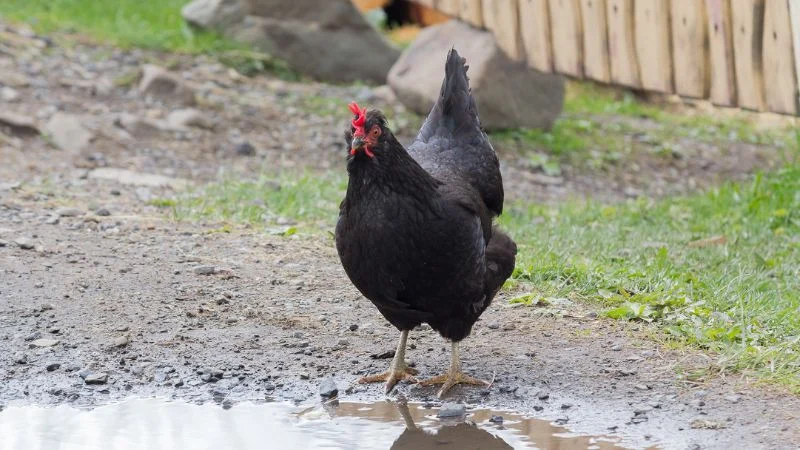
Highlights:
• Excellent layers: ~250–300 large, light-brown eggs per year.
• Gentle, non-aggressive temperament – great with kids and mixed flocks.
• Medium-sized birds (~6.5–8.5 lb), calm eaters, and not destructive.
• Cold-hardy and adaptable to a variety of U.S. climates.
Watch-outs:
• Their docile nature means they can get pushed aside at feeding time. Use long or multi-port feeders if housed with more dominant breeds.
• Prone to weight gain on all-day free feeding – consider scheduled feeding to maintain healthy weight.
🐔 ISA Brown
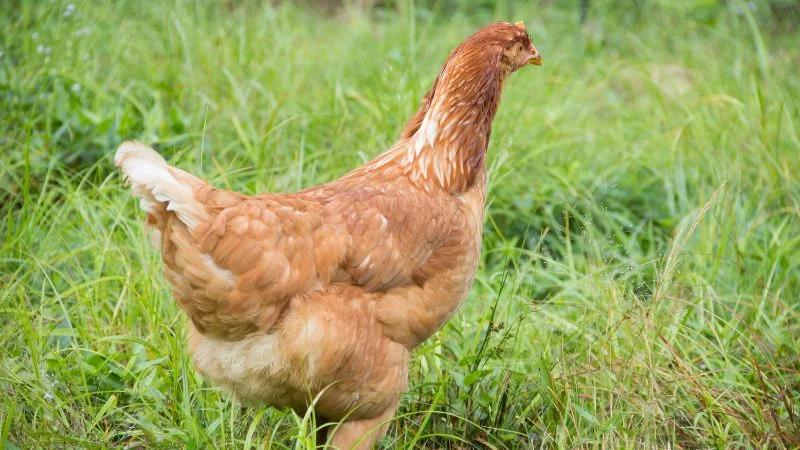
Highlights:
• Outstanding layers: ~300–320 large brown eggs per year.
• Early maturing (start laying at ~16–18 weeks), consistent production during first 1–2 years.
• Calm, easy to handle, and do well in smaller coops or backyard setups.
Watch-outs:
• Shorter lifespan compared to heritage breeds, and may burn out without rest periods.
• Require high-quality feed – use a covered feeder to keep it dry and clean, and consider adding calcium or vitamins as needed.
👉 Read the full guide to raising ISA Brown hens: ISA Brown Chickens: A Complete Guide for Backyard Egg Layers to get care tips, nutrition advice, and pros & cons.
🐔 Barred Rock
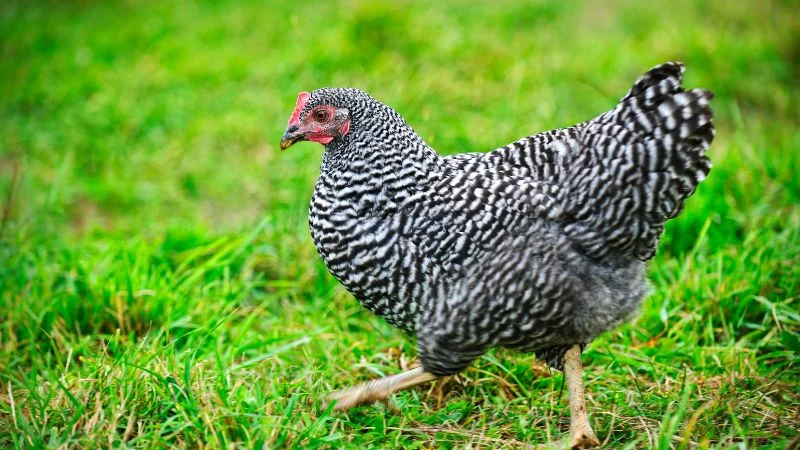
Highlights:
• Dual-purpose: good layers (~200–250 eggs/year) and tasty meat birds.
• Friendly, cold-tolerant, and easy to care for – ideal for small homesteads in temperate regions.
• Striking black-and-white barred plumage – beautiful addition to the flock.
Watch-outs:
• Not as high-producing as ISA Browns or Leghorns.
• Can gain weight easily – monitor portions to avoid obesity, which can reduce egg production.
🐔 Rhode Island Red
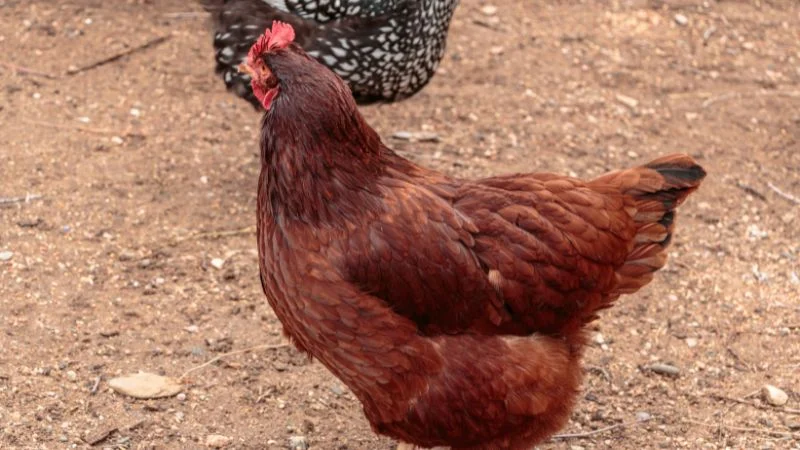
Highlights:
• Dual-purpose breed: strong layers (~250–300 eggs/year) and flavorful meat.
• Hardy and disease-resistant, does well in rougher conditions.
• Active and great foragers – perfect for free-range setups.
Watch-outs:
• Some individuals, especially roosters, can be aggressive – not ideal for mixed flocks with docile breeds or households with small children.
• Agile and adventurous – needs a secure coop if free-ranging to prevent escapes.
🐔 Orpington
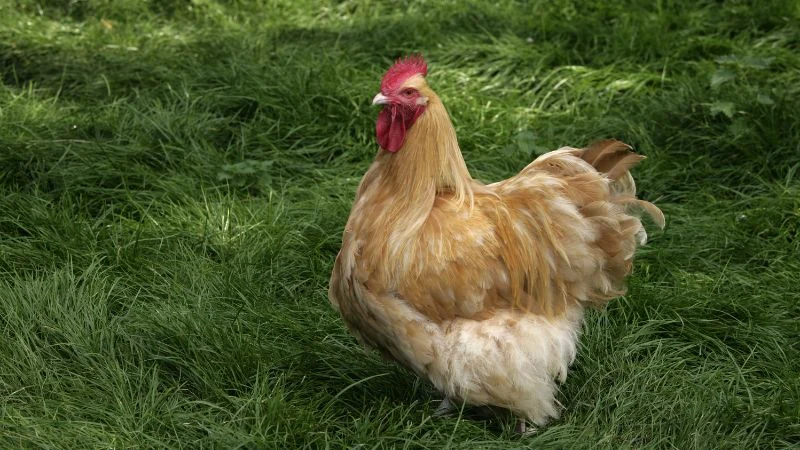
Highlights:
• Super docile and kid-friendly – great family chickens.
• Thick plumage makes them very cold-hardy, ideal for northern climates.
• Decent layers (~200–280 large brown eggs/year), and often go broody easily.
Watch-outs:
• Can get overweight if kept in confinement too long – encourage exercise or feed with care.
• Their dense feathers can trap moisture – keep the coop dry and well-ventilated to avoid mites or fungal issues.
Below is a summary table
| Breed | Eggs/year | Temperament | Cold Hardy | Best for |
| Australorp | 250–300 | Very gentle | Yes | Families, Mixed flocks |
| ISA Brown | 300–320 | Friendly | Moderate | Egg production only |
| Barred Rock | 200–250 | Calm | Yes | Dual-purpose, Easy to raise |
| Rhode Island Red | 250–300 | Active | Yes | Free-range setups |
| Orpington | 200–280 | Very docile | Yes | Families, Cold climates |
If you don’t have prior experience raising chickens, I sincerely recommend starting with 2 to 3 breeds from this group. They’ll help you get off to a smooth start with minimal risk and fresh eggs every day.
Of course, choosing a chicken breed also somewhat reflects the personality of the keeper. I have a friend who cared about only one thing: the eggs had to be truly delicious and unique. In the end, he chose to raise Marans. While Marans aren’t the easiest breed for beginners, their egg quality is outstanding: dark yolks, rich and creamy flavor, highly nutritious — plus their eggs come in a stunning chocolate brown shell. If you are a foodie who doesn’t mind investing more time in care, Marans are definitely worth trying.

That said, I want to be honest: there is no one perfect breed for everyone. The most important thing is how well a breed matches your conditions and goals. I’ve tried to simplify the breed selection process to help you easily pick one or a few suitable breeds to start with.
You also don’t need to stress or obsess over every single strength or weakness. The truth is: all 15 breeds I listed here are very reliable — widely raised, proven in practice, and suitable for family-scale farming. There are even many other breeds not on this list that Americans successfully raise. So feel free to choose based on your own conditions and inspiration — start with an easy-to-raise breed, and gradually you’ll find your own “chicken-keeping style!”
You can check out this reputable hatchery site to explore and purchase suitable chicken breeds: meyerhatchery.com
Conclusion
Raising laying hens is not only a hobby but also a wonderful way to produce clean, safe food for your family. Whether you prioritize egg production, calm temperament, or heat tolerance — as long as you identify your key criteria clearly, choosing the right breed won’t be too difficult.
Start small, experiment with 2–3 breeds that seem best for you, and observe which one truly thrives in your backyard. To support your hens’ health from day one, don’t forget a reliable chicken feeder and a well-suited chicken waterer.
Wishing you success in finding your ideal flock and many joyful mornings collecting fresh eggs!

